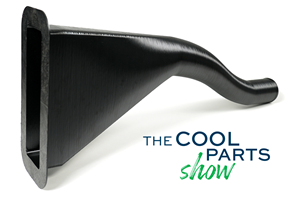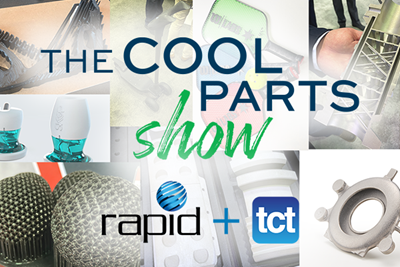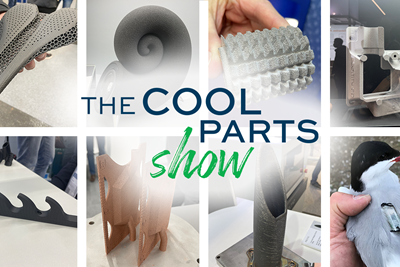8 Cool Parts From RAPID+TCT 2022: The Cool Parts Show #46
AM parts for applications from automotive to aircraft to furniture, in materials including ceramic, foam, metal and copper-coated polymer.
Share
RAPID+TCT is North America’s largest annual trade show devoted to additive manufacturing. It was held this year in Detroit, Michigan. Stephanie Hendrixson and I were there, and we captured this sample of noteworthy end-use 3D printed parts seen at the show. One striking thing about this collection is the range of material possibilities it represents. Additive manufacturing applications in metal and polymer are here, along with ceramic, foam, and polymer and metal together. | This episode of The Cool Parts Show brought to you by Carpenter Additive
The Cool Parts Show is a video series from Additive Manufacturing Media that explores the what, how and why of unusual 3D printed parts. Watch more here.
Have a cool part to share? Email us.
Related Resources
- Jeol electron beam melting system
- XJet's ceramic 3D printing
- Dimensional Innovations art/furniture at IDS Center in Minneapolis
- Braskem 3D printed polymer in rugged application: dog wheelchair
- 3DEO's metal additive manufacturing system
- Jabil PK 5000 polymer
- Another 3D printed helmet — this one for martial arts
- Another application of Adaptive3D flexible 3D printing polymer
- 3D printing electroplating specialist RePliForm
- Electroplating (and other surface finishing processes) for AM parts
- EOS and algorithmic engineering design system by Hyperganic
- Our full report from RAPID+TCT 2022 — AM Radio podcast
Transcript
Peter Zelinski
I'm Pete.
Stephanie Hendrixson
I'm Stephanie.
Peter Zelinski
Welcome to The Cool Parts Show.
Stephanie Hendrixson
This is a special episode of the show all about cool parts that we saw at Rapid + TCT 2022 in Detroit.
Peter Zelinski
This is not a countdown. It's a no particular order and it's just a sample. We saw tons of cool stuff at Rapid + TCT. Here's a sample of what we saw.
Stephanie Hendrixson
Okay. Our first part comes from JEOL. This is a Japanese company that just recently launched an electron beam melting additive manufacturing machine into the market. But JEOL has a long history of using electron beam technology. They make things like scanning electron microscopes, and now they're applying their knowledge of how to design and control electron beam systems to additive manufacturing. So the part we are looking at is actually a part of that electron beam melting 3D printer, which is itself 3D printed through electron beam melting. Specifically, this is the column for the electron gun. This is a component that would typically be machined, usually out of a material like carbon steel. And it needs to be very, very rigid. Any sort of vibration could mess with the performance of the electron gun. In this case, JEOL chose to 3D print it. They used electron beam melting, of course, and they made it out of titanium. They were able to lightweight this component. So you can see this sort of like beautiful lattice they introduced to kind of showcase that. And this component was available faster. Because they were able to electron beam melt it, JEOL was able to do the manufacturing in-house rather than outsource it to another manufacturer.
Peter Zelinski
Here is a ceramic piston for a real automobile. This was developed by Panopoulos Automotive in Greece for their Chaos ultra car in development. Like a sports car that's aimed for speeds above 300 miles per hour. A ceramic piston can take the heat. At rapid + TCT XJet had this on display. The piston was made using XJet’s NanoParticle Jetting system for 3D printing. XJet’s process jets material using very, very fine particulate, which makes it possible of attaining geometrically very precise features. Meaning there are components that become candidates for ceramic as the material where you wouldn't think of them as being ceramic applications. Now ceramic engine components, the application, the importance of this potentially goes way beyond just going fast. Run a car engine at much higher temperatures and you can get more energy efficiency, get more power out of the same amount of fuel potentially at higher temperatures, get to an energy efficiency of an internal combustion engine that rivals the overall efficiency of an electric vehicle.
Stephanie Hendrixson
Our next part is actually a collection of parts made by dimensional innovations. This company uses large format additive manufacturing to produce architectural elements, artwork and now furniture. This is a collaboration between Dimensional Innovations, Braskem and Slice Lab Design Studio. So this was a test of one of Braskem's new materials. It is a carbon fiber reinforced polypropylene made from recycled bottle caps. Dimensional Innovations printed this table and chairs using their Thermwood LSAM large scale additive manufacturing machine. And something distinctive about this printer is that it has this roller behind the nozzle that sort of compresses and pushes down the material to make sure that there's good layer adhesion. That actually proved to be a challenge in this project. Dimensional Innovations was using a not standard nozzle. They were using one with a smaller bead size because they wanted to create these cool topographic features on this furniture. But that smaller bead size meant that the roller was compressing the material too much. It was causing kind of this oozing effect. And so they had to go through a lot of iterations to just kind of figure out the right printer parameters, the right speeds and feeds, basically to figure out how to work with this material and that new nozzle. So this is just a great illustration of how the material, the design, the printer all have to work together for an application like this to work. And now they've got it figured out. They've got a way to print with this material to make products like this.
Peter Zelinski
This little part is a component of a ball screw mechanism in an aircraft. 3DEO, California, was showing this among various other metal 3D printed components. 3DEO manufactures components additively using its own process and its own platform. It involves spraying metal powder along with a binding agent, machining forms as they're built in the green state, then sintering after that. This part is made of 17-4 PH Stainless, it is a ball return tube and one of the critical requirements is consistent roundness and diameter of the passage all the way through this curving form. So just taking a tube, a tube segment, and bending it into this form would not have been a candidate for this part. This part is notable because of what it represents. This is additive manufacturing arriving in full scale industrial production. This ball return 3DEO is currently manufacturing this at the rate of 13,000 per year.
Stephanie Hendrixson
All right. We're going to go from aerospace back down to earth. This is the KAV Portola bike helmet. It was on display in the Jabil booth. So this is a custom helmet, KAV can take measurements of a biker's head and produce a helmet that is custom made to their anatomy. This helmet also has some special features. It has sound dampening. It's about 25% lighter than a typical high end bike helmet. But what's really cool here is that the filament, the material that was used to make this helmet was created specifically for this application. So KAV came to Jabil, they were looking for a filament that they could extrude to get the customization in this product, but it also needed to meet or exceed the safety requirements, it needed to have a good quality surface finish. And so Jabil took up the challenge. They created a proprietary material just for this application. It is a carbon fiber reinforced polymer. And that development took them only about six months.
Peter Zelinski
Desktop Metal now incorporates so many different additive manufacturing capabilities beyond desktop, beyond metal. Here's an application of 3D printing foam. DuraChain resin from desktop metal company Adaptive3D splits into two phases while curing. One phase can form a tough outer layer that contains and controls the expansion of the other phase. And Adaptive3D is learning how to 3D print with tiny pores of air inside. Pores that can expand along with the expansion of that second phase of the material. The effect is dramatic and also repeatable. A cushion printed this way could expand up to five times the size of the original 3D printed part, possibly more. The part that results, it feels like foam, it is foam. But without the wasted material that is characteristic of conventional foam manufacturing, which involves molding and cutting. Also, parts can be produced through 3D printing at a size much smaller than they'll ultimately be. A mattress, for example, could be 3D printed inside of a machine that has a build volume way smaller than a mattress, but it expands to its full size during curing.
Stephanie Hendrixson
This next part is a waveguide slot array antenna. So devices like this are usually made through machining or through assembly. You might have lots of little parts that you're brazing or soldering together. That means they're difficult to manufacture, they're limited in terms of geometry, and it's really difficult to make changes or to customize these things. So 3D printing this slot array antenna saved time and allowed for the features to be placed exactly where they were needed. But this part is a little bit of a fake out. It looks like copper and it's not. This is a stereolithography print. It is plastic that has been coated with copper. So I saw this part in the RepLiForm booth. They are the company that did the coating, and they had to do it in sort of a couple of steps. First, there was an electroless nickel plating process that had to be applied to make the part conductive and then they were able to electroplate it with copper. So this slot array antenna has a layer of copper on the outside that's about 50 microns thick, on the inside it gets down to five microns in some places, but just that thin film of copper is enough to let this plastic print function as if it is a solid piece of metal for this application. So this is low cost, fast, lightweight polymer 3D printing being made more functional with the application of an additional coating. So lots of potential applications for waveguide antennas like this as well as parts in other industries.
Peter Zelinski
Our final cool part from Rapid TCT 2022 has something to say about the future of design engineering. EOS was showing this part. It's made from Nickel Alloy 718 on one of EOS's laser power bed fusion systems. This is an Aerospike Engine and the geometric form was designed using an algorithmic modeling platform from Hyperganic. Aerospike Engine, a type of rocket engine that overcomes some of the performance losses that traditional rocket engines see at high altitudes. But it needs precise control over the direction of thrust, over the direction of fuel, over the combustion and all kinds of strategic cooling all through the form of the engine to maintain operation within a tight temperature window. Hyperganic's design platform allows complex parts like this with complex requirements to be designed automatically, once engineers have defined the algorithms, the equations that describe all of the various different needs of the performance of the part and also needs of the process. EOS is interested in this because the needs of the process can be defined within those engineering algorithms, within those equations from the very outset. Features, for example, that lend themselves very well to laser powder bed fusion. So having that definition from the outset assures from the beginning that the form the platform comes up with is going to be 3D printable.
Stephanie Hendrixson
There you have it, 8 cool parts from Rapid + TCT 2022. We have lots more event coverage as well. Check out Episode 18 of our AM Radio podcast for insights, observations and trends that we saw at the show. We also have photos and videos that we filmed on site. We will drop links to all of that in the show description below.
Peter Zelinski
Thanks for watching.
Related Content
Aircraft Ducts 3D Printed in Composite Instead of Metal: The Cool Parts Show #68
Eaton’s new reinforced PEKK, tailored to aircraft applications, provides a cheaper and faster way to make ducts compared to formed aluminum.
Read MoreUnderstanding PEKK and PEEK for 3D Printing: The Cool Parts Show Bonus
Both materials offer properties desirable for medical implants, among other applications. In this bonus episode, hear more from Oxford Performance Materials and Curiteva about how these companies are applying PEKK and PEEK, respectively.
Read More3D Printed Cutting Tool for Large Transmission Part: The Cool Parts Show Bonus
A boring tool that was once 30 kg challenged the performance of the machining center using it. The replacement tool is 11.5 kg, and more efficient as well, thanks to generative design.
Read More3D Printed NASA Thrust Chamber Assembly Combines Two Metal Processes: The Cool Parts Show #71
Laser powder bed fusion and directed energy deposition combine for an integrated multimetal rocket propulsion system that will save cost and time for NASA. The Cool Parts Show visits NASA’s Marshall Space Flight Center.
Read MoreRead Next
8 Cool Parts From RAPID+TCT 2021: The Cool Parts Show #32
North America’s largest AM trade show resumed! Here are some of the coolest cool parts we found.
Read MoreRAPID + TCT 2022 Report: Advancing into the Next Season of Additive Manufacturing: AM Radio #18
Editors Stephanie Hendrixson, Peter Zelinski and Julia Hider share observations, insights and photos from the latest RAPID + TCT trade show.
Read More8 Cool Parts From Formnext 2021: The Cool Parts Show #36
The world’s leading trade show for industrial 3D printing returned as an in-person event. Among all the additive manufacturing technology showcased at the show, we also found our most amazing batch of cool parts so far.
Read More












